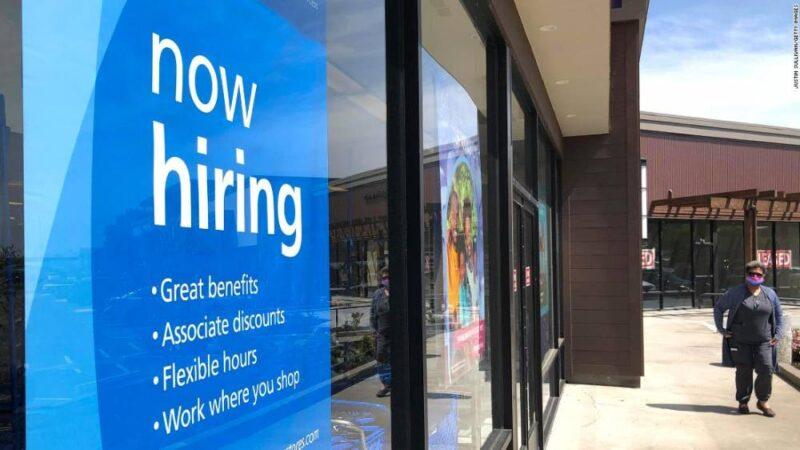Since the pandemic began, millions of women have left the workforce. And many of them have done so because of caregiving responsibilities that have traditionally fallen to women.
More from Success
Why some companies want everyone back in the office
The CDC’s new mask guidelines made things more complicated for employers
Here’s what Salesforce has learned as it reopens offices
Re-entering the workforce after an extended absence is often a difficult path, and the longer you’re out, the harder it can be to get back in.
“One area in which [the US labor market] is just not that flexible is letting people take time out of work and then come back in without there being kind of a ‘Scarlet ‘L’ for ‘Leaver’ on their sweater that signals to the labor market that somehow they are damaged goods,” said Betsey Stevenson, professor of public policy and economics at the University of Michigan.
For years, companies like Goldman Sachs, Cloudflare, and IBM, have offered return-to-work programs as a way to help professionals transition back into the workforce after a long break.

Offices are reopening. For parents, that raises a childcare problemReturnships, as they are often called, typically run for a few months, offering training, experience and networking opportunities to workers — usually mothers — who’ve been out of the workforce for an extended period of time. Read More”There are lots of exits off the highway of our lifetime work, but very few on-ramps. And returnships are one of those on-ramps,” said Stevenson. And more recently, there’s been growing interest from companies to launch this type of program, said Tami Forman, chief executive of Path Forward, an organization that works with companies to create returnship programs. “We had more programs start this spring,” she said. “We are seeing more companies initiate and launch new programs.”
Seeing past the resume gap
Career gaps on a resume can be viewed negatively, but when all returnship applicants have a career gap in their work history, it forces hiring managers to look past it.”The goal of these programs is to give companies a way to incentivize managers to hire people that they are otherwise overlooking who are perfectly well-qualified for jobs,” said Forman.Eligibility varies by company but tends to require at least two years out of the workforce and a minimum of five years of prior professional experience, according to Forman. “There certainly is a drop-off in callback rates for anyone who has a gap in their resume, but at the two-year mark, it really falls off a cliff,” said Forman, who added that being identified as a caregiver also decreases callback rates.Grubhub, which is in the middle of its first returnship program, held training for its managers so they would know what to look for when choosing applicants for the program. “We knew the interview process would need to look different in… assessing the skills they would have had at the time they stepped out of the workforce,” said Kelley Berlin, Grubhub’s chief human resources officer. “We couldn’t evaluate them on their current technology skills. We had to look at their performance level and potential as it related to when they stepped out.”As we enter the second year of a global pandemic, however, companies may start to view protracted employment gaps differently, particularly in light of school and daycare shutdowns. “Everyone’s awareness of caregiving as a conflict has been raised,” she said. “The recognition that it often isn’t a choice or it is a choice that is so constrained by external factors that individual families can’t control.”
The role of returnships
Goldman Sachs launched a returnship program in 2008, which requires applicants to have been out of the workforce for two years or more. But the company is considering lowering that minimum, which would expand the applicant pool to workers who left during the pandemic. “We are quite focused on how to make shifts to those eligibility requirements because there would have been women who took just a year off at the height of Covid and those are women who should have the opportunity to on-ramp,” said Megan Hogan, Goldman’s chief diversity officer. She added that tapping the talent that left the workforce during the pandemic will help the bank stay competitive.The first week of Goldman Sachs’ 12-week program focuses on training, followed by an apprenticeship in one of the bank’s divisions. Participants are paired with a manager, a coach and previous returnees. On average, the company gets about 1,000 applications annually for its US program and accepts 25 to 30. Roughly 75% of those who go through the program are extended offers to become full-time employees.

Major disappointment: America added way fewer jobs than expected in AprilWells Fargo launched its Glide Relaunch program in the US as the pandemic was raging last fall. It received more than 800 applications, resulting in a 34-person class. This year’s program was fully remote, and required at least a two-year career break and seven years of prior experience. While the foundations for the program began before the pandemic, the timing of the launch brought a lot of interest.”Because the program launched in November 2020, the talent pool was incredible in terms of what we received,” said Sandra Fernandes, who runs Wells Fargo’s returnship program. “With our inaugural posting attracting about 836 applicants, I think that resulted only because of the job market that existed that was matching what Wells Fargo had to offer.”Participants were paid $40 an hour during the returnship and the salaries of the full-time positions that were offered after the eight-week program were $100,000 or above, according to Fernandes. “We were so impressed with what our inaugural program brought to the table….for year two we will be growing the class by three times, working toward bringing in 100 interns to join the business,” said Fernandes.The pandemic’s impact on women’s progress in the labor market played a role in audio storytelling company Audible’s decision to launch its returnship program, Next Chapter, earlier this year. Its first class completes the program this month. “We felt that launching during the pandemic would be best because we would be able to support as many caregivers and their families due to the joblessness caused by the pandemic,” said Anne Erni, Audible’s chief people officer. “Knowing that it was very hard for professionals on caregiving career breaks to re-enter the workforce, we knew it would be exponentially harder during the pandemic.”
She added that the program, which runs 16 weeks, will help provide a level playing field. “No matter how much progress we’ve made in terms of sharing home responsibilities with our partners…the burden of care still often falls on women. So women had to make that hard choice to off-ramp partially or fully,” said Erni. “We need to pick up the progress.”
Source: edition.cnn.com

